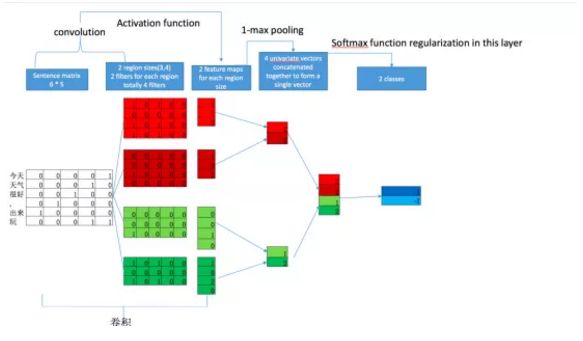python cnn代码详解图解_TextCNN 代码详解(附测试数据集以及GitHub 地址)
前言:本篇是TextCNN系列的第二篇,分享TextCNN的代码
前两篇可见:
一、textCNN整体框架
1. 模型架构
图一:textCNN 模型结构示意
2. 代码架构
text_cnn.py 定义了textCNN 模型网络结构
model.py 定义了训练代码
data.py 定义了数据预处理操作
data_set 存放了测试数据集合. polarity.neg 是负面情感文本, polarity.pos 是正面情感文本
train-eval.sh 执行脚本
3.代码地址
部分代码参考了 此处代码
4.训练效果说明:
图三:训练效果展示
二、textCNN model 代码介绍
2.1 wordEmbedding
图四:WordEmbedding 例子说明
简要说明:
vocab_size: 词典大小18758
embedding_dim: 词向量大小 为128
seq_length: 句子长度,设定最长为56
embedding_look: 查表操作 根据每个词的位置id 去初始化的w中寻找对应id的向量. 得到一个tensor :[batch_size, seq_length, embedding_size] 既 [?, 56, 128], 此处? 表示batch, 即不知道会有多少输入。
#embedding layer
with tf.name_scope("embedding"):
self.W= tf.Variable(tf.random_uniform([self._config.vocab_size, self._config.embedding_dim], -1.0, 1.0),
name="W")
self.char_emb=tf.nn.embedding_lookup(self.W, self.input_x)
self.char_emb_expanded= tf.expand_dims(self.char_emb, -1)
tf.logging.info("Shape of embedding_chars:{}".format(str(self.char_emb_expanded.shape)))
举例说明:我们有一个词典大小为3的词典,一共对应三个词 “今天”,“天气” “很好“,w =[[0,0,0,1],[0,0,1,0],[0,1,0,0]]。
我们有两个句子,”今天天气“,经过预处理后输入是[0,1]. 经过embedding_lookup 后,根据0 去查找 w 中第一个位置的向量[0,0,0,1], 根据1去查找 w 中第二个位置的向量[0,0,1,0] 得到我们的char_emb [[0,0,0,1],[0,0,1,0]]
同理,“天气很好”,预处理后是[1,2]. 经过经过embedding_lookup 后, 得到 char_emb 为[[0,0,1,0],[0,1,0,0]]
因为, 卷积神经网conv2d是需要接受四维向量的,故将char_embdding 增广一维,从 [?, 56, 128] 增广到[?, 56, 128, 1]
2.2 Convolution 卷积 + Max-Pooling
简要说明:
filter_size= 3,4,5. 每个filter 的宽度与词向量等宽,这样只能进行一维滑动。
每一种filter卷积后,结果输出为[batch_size, seq_length - filter_size +1,1,num_filter]的tensor。
#convolution + pooling layer
pooled_outputs =[]for i, filter_size inenumerate(self._config.filter_sizes):
with tf.variable_scope("conv-maxpool-%s" %filter_size):#convolution layer
filter_width =self._config.embedding_dim
input_channel_num= 1output_channel_num=self._config.num_filters
filter_shape=[filter_size, filter_width, input_channel_num, output_channel_num]
n= filter_size * filter_width *input_channel_num
kernal= tf.get_variable(name="kernal",
shape=filter_shape,
dtype=tf.float32,
initializer=tf.random_normal_initializer(stddev=np.sqrt(2.0 /n)))
bias= tf.get_variable(name="bias",
shape=[output_channel_num],
dtype=tf.float32,
initializer=tf.zeros_initializer)#apply convolution process
#conv shape: [batch_size, max_seq_len - filter_size + 1, 1, output_channel_num]
conv =tf.nn.conv2d(
input=self.char_emb_expanded,
filter=kernal,
strides=[1, 1, 1, 1],
padding="VALID",
name="cov")
tf.logging.info("Shape of Conv:{}".format(str(conv.shape)))#apply non-linerity
h = tf.nn.relu(tf.nn.bias_add(conv, bias), name="relu")
tf.logging.info("Shape of h:{}".format(str(h)))#Maxpooling over the outputs
pooled =tf.nn.max_pool(
value=h,
ksize=[1, self._config.max_seq_length - filter_size + 1, 1, 1],
strides=[1, 1, 1, 1],
padding="VALID",
name="pool")
tf.logging.info("Shape of pooled:{}".format(str(pooled.shape)))
pooled_outputs.append(pooled)
tf.logging.info("Shape of pooled_outputs:{}".format(str(np.array(pooled_outputs).shape)))#concatenate all filter's output
total_filter_num = self._config.num_filters *len(self._config.filter_sizes)
all_features= tf.reshape(tf.concat(pooled_outputs, axis=-1), [-1, total_filter_num])
tf.logging.info("Shape of all_features:{}".format(str(all_features.shape)))
由于我们有三种filter_size, 故会得到三种tensor
第一种 tensor, filter_size 为 3处理后的,[?,56-3+1,1, 128] -> [?,54,1, 128]
第二种 tensor, filter_size 为 4处理后的,[?,56-4+1,1, 128] -> [?,53,1, 128]
第三种 tensor, filter_size 为 5处理后的,[?,56-5+1,1, 128] -> [?,52,1, 128]
再用ksize=[?,seq_length - filter_size + 1,1,1]进行max_pooling,得到[?,1,1,num_filter]这样的tensor. 经过max_pooling 后
第一种 tensor, [?,54,1, 128] –> [?,1,1, 128]
第二种 tensor, [?,53,1, 128] -> [?,1,1, 128]
第三种 tensor, [?,52,1, 128] -> [?,1,1, 128]
将得到的三种结果进行组合,得到[?,1,1,num_filter*3]的tensor.最后将结果变形一下[-1,num_filter*3],目的是为了下面的全连接
[?,1,1, 128], [?,1,1, 128], [?,1,1, 128] –> [?, 384]
2.3 使用softmax k分类
图六:softmax 示意
简要说明:
label_size 为 文本分类类别数目,这里是二分类,然后得到输出的结果scores,以及得到预测类别在标签词典中对应的数值predicitons。使用交叉墒求loss.
with tf.name_scope("output"):
W=tf.get_variable(
name="W",
shape=[total_filter_num, self._config.label_size],
initializer=tf.contrib.layers.xavier_initializer())
b= tf.Variable(tf.constant(0.1, shape=[self._config.label_size]), name="b")
l2_loss+=tf.nn.l2_loss(W)
l2_loss+=tf.nn.l2_loss(b)
self.scores= tf.nn.xw_plus_b(all_features, W, b, name="scores")
self.predictions= tf.argmax(self.scores, 1, name="predictions")#compute loss
with tf.name_scope("loss"):
losses= tf.nn.softmax_cross_entropy_with_logits(logits=self.scores, labels=self.input_y)
self.loss= tf.reduce_mean(losses) + self._config.l2_reg_lambda * l2_loss
三、 textCNN 训练模块
简要说明:利用数据预处理模块加载数据,优化函数选择adam, 每个batch为64. 进行处理
deftrain(x_train, y_train, vocab_processor, x_dev, y_dev, model_config):
with tf.Graph().as_default():
sess=tf.Session()
with sess.as_default():
cnn=TextCNNModel(
config=model_config,
is_training=FLAGS.is_train
)#Define Training proceduce
global_step = tf.Variable(0, name="global_step", trainable=False)
optimizer= tf.train.AdamOptimizer(1e-3)
grads_and_vars=optimizer.compute_gradients(cnn.loss)
train_op= optimizer.apply_gradients(grads_and_vars, global_step=global_step)#Checkpoint directory, Tensorflow assumes this directioon already exists so we need to create it
checkpoint_dir = os.path.abspath(os.path.join(FLAGS.output_dir, "checkpoints"))
checkpoint_prefix= os.path.join(checkpoint_dir, "model")if notos.path.exists(checkpoint_dir):
os.makedirs(checkpoint_dir)
saver= tf.train.Saver(tf.global_variables(), max_to_keep=FLAGS.keep_checkpoint_max)#Write vocabulary
vocab_processor.save(os.path.join(FLAGS.output_dir, "vocab"))#Initialize all variables
sess.run(tf.global_variables_initializer())deftrain_step(x_batch, y_batch):"""A singel training step
:param x_batch:
:param y_batch:
:return:"""feed_dict={
cnn.input_x: x_batch,
cnn.input_y: y_batch
}
_, step, loss, accuracy=sess.run(
[train_op, global_step, cnn.loss, cnn.accuracy],
feed_dict)
time_str=datetime.datetime.now().isoformat()
tf.logging.info("{}: step {}, loss {:g}, acc {:g}".format(time_str, step, loss, accuracy))def dev_step(x_batch, y_batch, writer=None):"""Evaluates model on a dev set"""feed_dict={
cnn.input_x: x_batch,
cnn.input_y: y_batch
}
step, loss, accuracy=sess.run(
[global_step, cnn.loss, cnn.accuracy],
feed_dict)
time_str=datetime.datetime.now().isoformat()
tf.logging.info("{}: step {}, loss {:g}, acc {:g}".format(time_str, step, loss, accuracy))#Generate batches
batches =data.DataSet.batch_iter(list(zip(x_train, y_train)), FLAGS.batch_size, FLAGS.num_epochs)#Training loop, For each batch ..
for batch inbatches:
x_batch, y_batch= zip(*batch)
train_step(x_batch, y_batch)
current_step=tf.train.global_step(sess, global_step)if current_step % FLAGS.save_checkpoints_steps ==0:
tf.logging.info("\nEvaluation:")
dev_step(x_dev, y_dev)if current_step % FLAGS.save_checkpoints_steps ==0:
path= saver.save(sess, checkpoint_prefix, global_step=current_step)
tf.logging.info("Saved model checkpoint to {}\n".format(path))
四、textCNN 数据预处理
简要说明:处理输入数据
classDataSet(object):def __init__(self, positive_data_file, negative_data_file):
self.x_text, self.y=self.load_data_and_labels(positive_data_file, negative_data_file)defload_data_and_labels(self, positive_data_file, negative_data_file):#load data from files
positive_data = list(open(positive_data_file, "r", encoding='utf-8').readlines())
positive_data= [s.strip() for s inpositive_data]
negative_data= list(open(negative_data_file, "r", encoding='utf-8').readlines())
negative_data= [s.strip() for s innegative_data]#split by words
x_text = positive_data +negative_data
x_text= [self.clean_str(sent) for sent inx_text]#generate labels
positive_labels = [[0, 1] for _ inpositive_data]
negative_labels= [[1, 0] for _ innegative_data]
y=np.concatenate([positive_labels, negative_labels], 0)return[x_text, y]defclean_str(self, string):"""Tokenization/string cleaning for all datasets except for SST.
Original taken from https://github.com/yoonkim/CNN_sentence/blob/master/process_data.py"""string= re.sub(r"[^A-Za-z0-9(),!?\'\`]", " ", string)
string= re.sub(r"\'s", "\'s", string)
string= re.sub(r"\'ve", "\'ve", string)
string= re.sub(r"n\'t", "n\'t", string)
string= re.sub(r"\'re", "\'re", string)
string= re.sub(r"\'d", "\'d", string)
string= re.sub(r"\'ll", "\'ll", string)
string= re.sub(r",", ",", string)
string= re.sub(r"!", "!", string)
string= re.sub(r"\(", "\(", string)
string= re.sub(r"\)", "\)", string)
string= re.sub(r"\?", "\?", string)
string= re.sub(r"\s{2,}", " ", string)returnstring.strip().lower()def batch_iter(data, batch_size, num_epochs, shuffle=True):"""Generates a batch iterator for a dataset."""data=np.array(data)
data_size=len(data)
num_batches_per_epoch= int((len(data) - 1) / batch_size) + 1
for epoch inrange(num_epochs):#Shuffle the data at each epoch
ifshuffle:
shuffle_indices=np.random.permutation(np.arange(data_size))
shuffled_data=data[shuffle_indices]else:
shuffled_data=datafor batch_num inrange(num_batches_per_epoch):
start_index= batch_num *batch_size
end_index= min((batch_num + 1) *batch_size, data_size)yield shuffled_data[start_index:end_index]
五、模型训练
简要说明:修改code_dir , 执行train-eval.sh 即可执行
#!/bin/bash
export CUDA_VISIBLE_DEVICES=0#如果运行的话,更改code_dir目录
CODE_DIR="/home/work/work/modifyAI/textCNN"MODEL_DIR=$CODE_DIR/model
TRAIN_DATA_DIR=$CODE_DIR/data_set
nohup python3 $CODE_DIR/model.py \--is_train=true \--num_epochs=200\--save_checkpoints_steps=100\--keep_checkpoint_max=50\--batch_size=64\--positive_data_file=$TRAIN_DATA_DIR/polarity.pos \--negative_data_file=$TRAIN_DATA_DIR/polarity.neg \--model_dir=$MODEL_DIR > $CODE_DIR/train_log.txt 2>&1 &
六、总结
介绍了textCNN基本架构,代码架构,项目地址,训练效果
详细说明textCNN 用tensorflow如何实现
介绍了textCNN 模型训练代码以及数据预处理模块
详细说明如何运行该项目
下一次会介绍如何调优textCNN 模型





